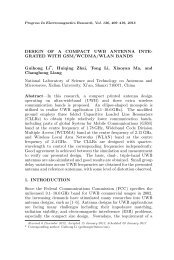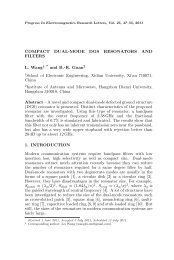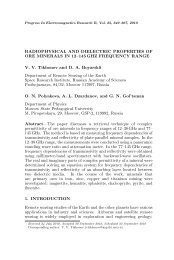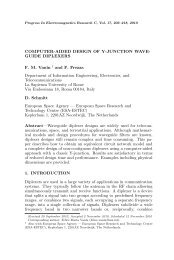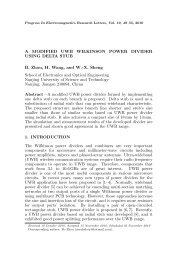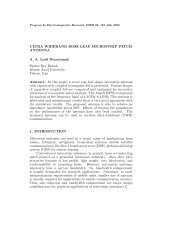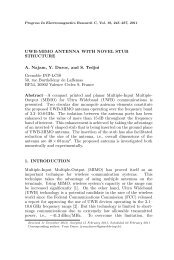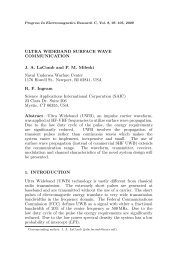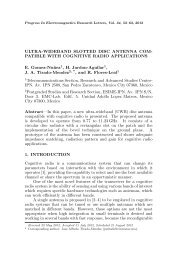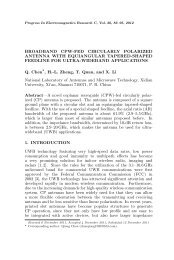CPW-FED SLEEVE MONOPOLE ANTENNA WITH - PIER
CPW-FED SLEEVE MONOPOLE ANTENNA WITH - PIER
CPW-FED SLEEVE MONOPOLE ANTENNA WITH - PIER
You also want an ePaper? Increase the reach of your titles
YUMPU automatically turns print PDFs into web optimized ePapers that Google loves.
24 Liu et al.<br />
1. INTRODUCTION<br />
The digital television (DTV) reception has been very attractive<br />
for applications in recent wireless communications. Many kinds of<br />
antennas for DTV reception have been studied [1–16], and delivering<br />
broadcast television signals to various terminals such as mobile<br />
phone [1], laptop computer [2, 3], multi-media player [4–6], vehicle [7]<br />
and the reception devices [8–16], etc.<br />
Basically, these structures belong to the monopole [2, 4–7, 11–15],<br />
dipole [1, 3, 8–10], planar [17] and the loop [16]. The characteristics of<br />
these antennas include broadband, compact, omidirectional patterns<br />
and high gain. In which, the sleeve monopole antenna is an attractive<br />
candidate for its impedance performance [11, 12, 15]. However, the<br />
circular polarization of these antennas has not been studied for DTV<br />
applications. Recent research has shown that there are certain benefits<br />
of polarization diversity and good reception to use circularly polarized<br />
(CP) antennas.<br />
Based on the sleeve monopole antenna [11, 12, 15], two complementary<br />
SIR radiators with longer and shorter electrical length are<br />
resonated for the lower and higher resonances of the desired band<br />
respectively. By inserting a parasitic sleeve with square loop, the<br />
impedance performance is dramatically improved. The asymmetrical<br />
radiators consists of the step impedance resonator (SIR) [14] and the<br />
complementary configuration [18, 19]. The CP operation for the proposed<br />
design can be achieved by properly adjusting the asymmetrical<br />
radiators. The variations of gap width and coupled space are studied<br />
for optimization. Orthogonal mode in surface current density and AR<br />
spectrums are applied for demonstrating the circular polarizations for<br />
UHF-bands. Also, the proposed antenna can be regarded as the antenna<br />
having <strong>CPW</strong>-fed. It is an available antenna for DTV reception<br />
and CP applications in spite of the compact size.<br />
2. <strong>ANTENNA</strong> CONFIGURATION AND BASIS<br />
The configuration of the proposed antenna is shown in Fig. 1. FR4<br />
substrate with thickness 1.6 mm is used. The dimensions are W1 =<br />
145.5 mm, W2 = 75 mm, W3 = 8 mm, W4 = W7 = 10 mm, W5 = 2 mm,<br />
W6 = 8 mm, W8 = 59.5 mm, Wf = 5.5 mm, s1 = 0.5 mm, s2 = 3 mm,<br />
L1 = 160 mm, L2 = 10 mm, L3 = 16 mm, L4 = 12 mm, L5 = 5.5 mm<br />
and L6 = 50 mm. The antenna is excited by using a <strong>CPW</strong>-fed<br />
and parasitized with a square loop sleeve. The antenna has two<br />
resonant distributions due to complementary SIR radiators shown in<br />
Fig. 2. The first (lower) and second (higher) resonant frequencies are





